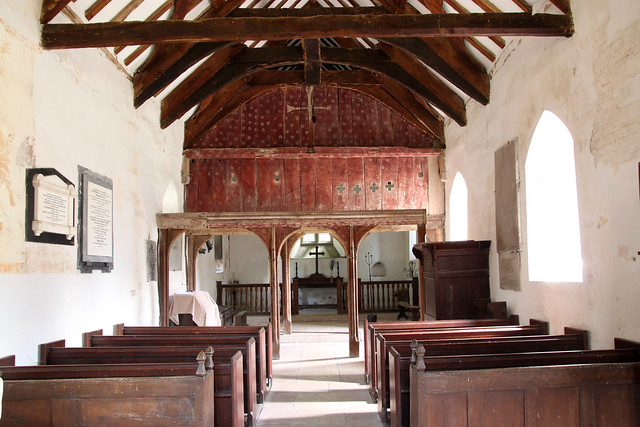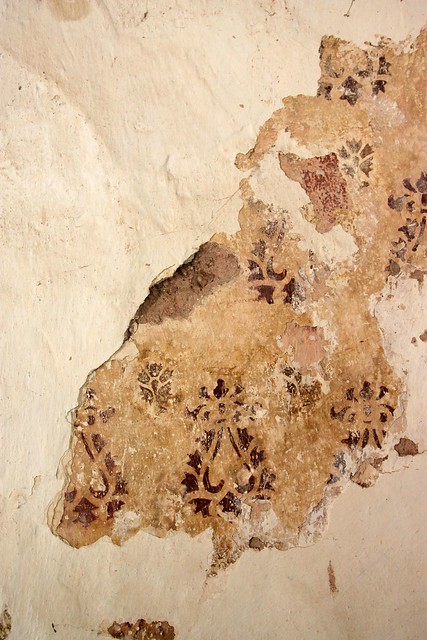Oxblood and flowers; Roods and counterchange
Llanelieu is a tiny hamlet on the northern edge of the Black Mountains in what was once the Welsh county of Brecknockshire and is now part of Powys.

The tiny church of St Ellyw, which gives its name to the settlement, is a single cell building that is predominately thirteenth century. It's sits in the valley bottom in its large churchyard and seems almost to grow out of the hillside. It's little bellcote at the west end, shelters a bell of the twelfth century, one of the earliest in Britain, indicating that there was a previous church building on this site. This rather humble exterior, rather belies what's inside. You push open the door and enter a very simple interior, but one that is dominated completely by an extraordinary ensemble: the remains of the late medieval rood screen, its tympanum and its fittings, all covered in red paint.

For those who are used to East Anglican screens with their wainscots, traceried openings and lofts supported on projecting coving, the rood screen here at Llanelieu is rather surprising. There is no wainscotting and never was, just two sets of triple arches, giving an uninterrupted view of the Chancel beyond. The floor of the loft was supported on these two sets of triple arches and the floor's timbers remain, though the plank floor itself has gone, along with the loft parapet.

The eastern set of triple arches supports a large superstructure, a Tympanum made of boards, that fills all the space right up to the roof. This forms a backdrop for the Rood beam, which is still in situ, supported north and south on corbels and upright posts set into the walls.

The whole of the Tympanum and in fact the rest of the structure of the screen is painted with a red pigment, which when analysed was found to be Oxblood. This is relieved with hundred upon hundreds of white stencilled roses.

The most remarkable thing about this whole ensemble, is that you can still see where the medieval Rood was located. The Rood was clearly put in place before the Tympanum was painted, for the shape of the lost Rood, which was apparently a splayed cross, is still marked out by the unpainted woodwork. The splayed foot of the cross clearly fitted into the mortice that still remains in the rood beam. Most scholars believe that the rood here didn't have attendant figures of Mary and John, but I wonder if this is correct? There is some infilling the in the beam left and right and perhaps the figures were attached here?

The bottom of the Tympanum has been pierced with a series of deliberate holes or squints, including a series of quatrefoils which are placed at a low level, quite close to where the floor of the loft once was. These would have given a view of the high altar from the rood loft for anyone up there, but when the loft parapet was still in place, would have been invisible from the west. Presumably the low-level quatrefoils are placed in order to allow someone standing in the loft to still see the high altar without kneeling or sitting down.

Of course the rood screen was only part of the visual landscape of this church building and other bits of evidence still remain that give us a sense of screen's visual context within the medieval church interior. Counterchange in decoration was typical of late medieval British art and there is evidence of counterchange in the interior scheme here at Llanelieu. The screen itself has a red colour scheme relieved with white stencilled roses, while in the chancel there are the remains of a white colour scheme relieved with red. Appearing from behind later plaster, is the late medieval wall decoration, an off-white limewash, powdered with large red stencilled motifs, interspersed with smaller flowers. It's difficult to tell due to oxidisation, but the smaller flowers appear to be green.

So if you were standing here in c.1500, you would have looked through this wall of Oxblood and white flowers, to a lighter, brighter Chancel with a vibrant, but less visually intense red and green colour scheme. Until the nineteenth century there was also a Celure attached to the ceiling over the loft here at Llanelieu. Perhaps it was like the Almeley celure with a white ground, painted to resemble a vault with a red and green counterchange? That would certainly have been a colour scheme that would have complemented the white, red and green counterchanage of the Chancel wallpaintings here at Llanelieu. Such a scheme for the Celure, would have drawn the eye to the image of the Rood, set against it's vibrant Oxblood ground.
N.B. The church is now in the care of the very excellent Friends of Friendless Churches and is open every day.

The tiny church of St Ellyw, which gives its name to the settlement, is a single cell building that is predominately thirteenth century. It's sits in the valley bottom in its large churchyard and seems almost to grow out of the hillside. It's little bellcote at the west end, shelters a bell of the twelfth century, one of the earliest in Britain, indicating that there was a previous church building on this site. This rather humble exterior, rather belies what's inside. You push open the door and enter a very simple interior, but one that is dominated completely by an extraordinary ensemble: the remains of the late medieval rood screen, its tympanum and its fittings, all covered in red paint.

For those who are used to East Anglican screens with their wainscots, traceried openings and lofts supported on projecting coving, the rood screen here at Llanelieu is rather surprising. There is no wainscotting and never was, just two sets of triple arches, giving an uninterrupted view of the Chancel beyond. The floor of the loft was supported on these two sets of triple arches and the floor's timbers remain, though the plank floor itself has gone, along with the loft parapet.

The eastern set of triple arches supports a large superstructure, a Tympanum made of boards, that fills all the space right up to the roof. This forms a backdrop for the Rood beam, which is still in situ, supported north and south on corbels and upright posts set into the walls.

The whole of the Tympanum and in fact the rest of the structure of the screen is painted with a red pigment, which when analysed was found to be Oxblood. This is relieved with hundred upon hundreds of white stencilled roses.

The most remarkable thing about this whole ensemble, is that you can still see where the medieval Rood was located. The Rood was clearly put in place before the Tympanum was painted, for the shape of the lost Rood, which was apparently a splayed cross, is still marked out by the unpainted woodwork. The splayed foot of the cross clearly fitted into the mortice that still remains in the rood beam. Most scholars believe that the rood here didn't have attendant figures of Mary and John, but I wonder if this is correct? There is some infilling the in the beam left and right and perhaps the figures were attached here?

The bottom of the Tympanum has been pierced with a series of deliberate holes or squints, including a series of quatrefoils which are placed at a low level, quite close to where the floor of the loft once was. These would have given a view of the high altar from the rood loft for anyone up there, but when the loft parapet was still in place, would have been invisible from the west. Presumably the low-level quatrefoils are placed in order to allow someone standing in the loft to still see the high altar without kneeling or sitting down.

Of course the rood screen was only part of the visual landscape of this church building and other bits of evidence still remain that give us a sense of screen's visual context within the medieval church interior. Counterchange in decoration was typical of late medieval British art and there is evidence of counterchange in the interior scheme here at Llanelieu. The screen itself has a red colour scheme relieved with white stencilled roses, while in the chancel there are the remains of a white colour scheme relieved with red. Appearing from behind later plaster, is the late medieval wall decoration, an off-white limewash, powdered with large red stencilled motifs, interspersed with smaller flowers. It's difficult to tell due to oxidisation, but the smaller flowers appear to be green.

So if you were standing here in c.1500, you would have looked through this wall of Oxblood and white flowers, to a lighter, brighter Chancel with a vibrant, but less visually intense red and green colour scheme. Until the nineteenth century there was also a Celure attached to the ceiling over the loft here at Llanelieu. Perhaps it was like the Almeley celure with a white ground, painted to resemble a vault with a red and green counterchange? That would certainly have been a colour scheme that would have complemented the white, red and green counterchanage of the Chancel wallpaintings here at Llanelieu. Such a scheme for the Celure, would have drawn the eye to the image of the Rood, set against it's vibrant Oxblood ground.
N.B. The church is now in the care of the very excellent Friends of Friendless Churches and is open every day.

Comments